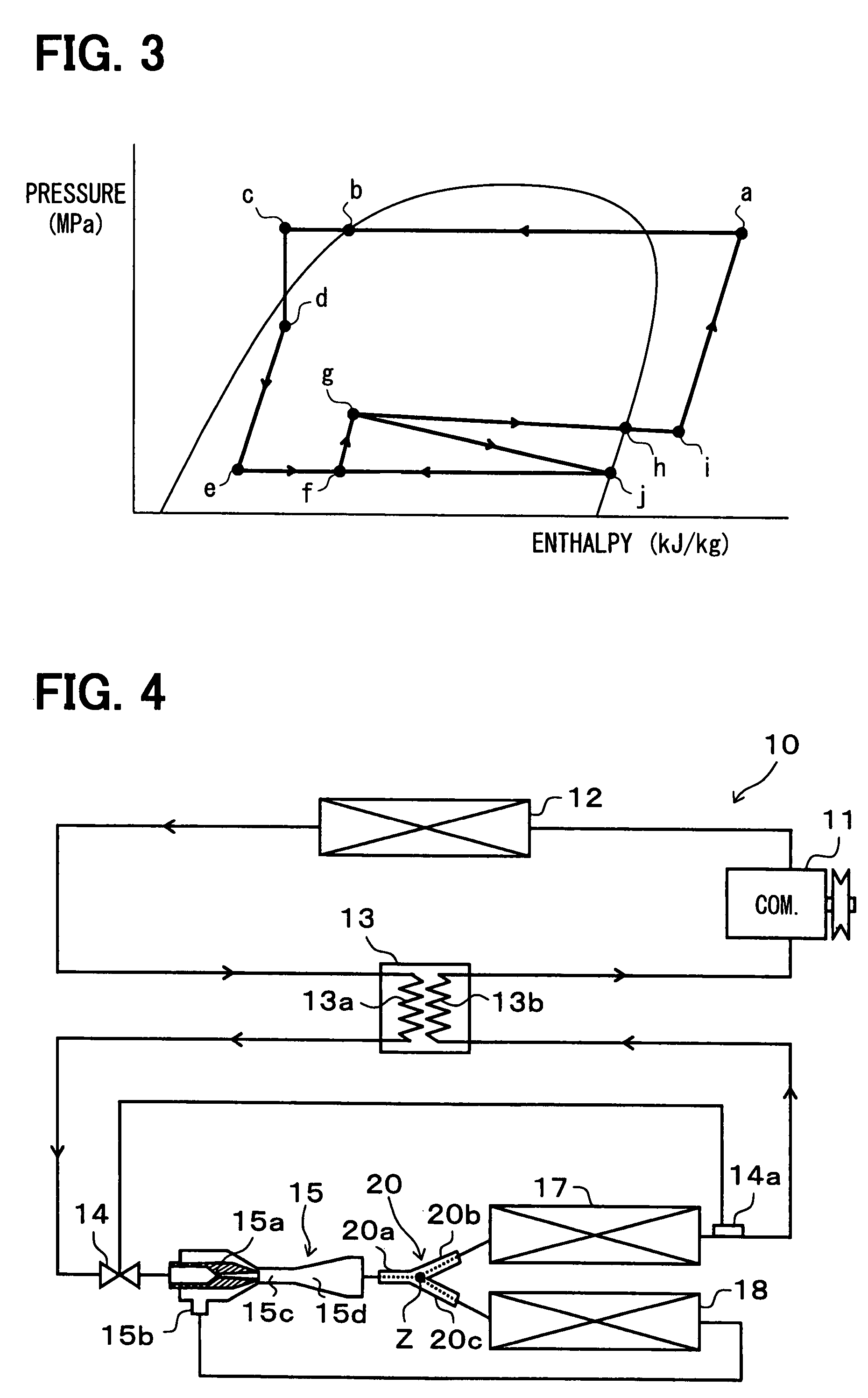Refrigerant cycle device
a cycle device and refrigerant technology, applied in the direction of cooling fluid circulation, lighting and heating apparatus, domestic cooling apparatus, etc., can solve the problems of loss of kinetic energy of refrigerant, reduced expansion, and reduced dynamic pressure of refrigeran
- Summary
- Abstract
- Description
- Claims
- Application Information
AI Technical Summary
Benefits of technology
Problems solved by technology
Method used
Image
Examples
first embodiment
[0041]A first embodiment of the invention will be described below with reference to FIGS. 1 to 3. A refrigerant cycle device 10 includes a refrigerant cycle in which refrigerant is circulated. In the refrigerant cycle, a compressor 11 is located to suck, compress, and then discharge the refrigerant. The compressor 11 is rotatably driven by a driving force transmitted from an engine for vehicle running (not shown) via a pulley and a belt, for example.
[0042]As the compressor 11, may be used either of a variable displacement compressor for being capable of adjusting a refrigerant discharge capacity depending on a change in discharge capacity, or a fixed displacement compressor for adjusting a refrigerant discharge capacity by changing an operating efficiency of the compressor by intermittent connection of an electromagnetic clutch. The use of an electric compressor as the compressor 11 can adjust the refrigerant discharge capacity by adjustment of the number of revolutions of an electr...
second embodiment
[0088]In the above-described first embodiment, the refrigerant distribution unit 16 having a T-shaped joint structure is employed. A refrigerant cycle device 10 of the second embodiment employs a refrigerant distribution unit 20 having a Y-shaped three-way joint structure as shown in FIGS. 4 and 5. The structures of other components in the refrigerant cycle device 10 may be the same as those in the first embodiment. FIG. 4 is a schematic diagram showing the refrigerant cycle device 10 of the second embodiment. FIG. 5 is a sectional view in the axial direction of an introduction pipe 20a of the refrigerant distribution unit 20.
[0089]The refrigerant distribution unit 20 includes, as shown in FIG. 5, the introduction pipe 20a for allowing the refrigerant to flow thereinto, a first leading pipe 20b for allowing the refrigerant to flow to the first evaporator 17, and a second leading pipe 20c for allowing the refrigerant to flow to the second evaporator 18.
[0090]Specifically, the introdu...
third embodiment
[0096]In the third embodiment, the structure of the refrigerant distribution unit 16 described in the first embodiment is used. As shown in the entire construction diagram of FIG. 6, a convergent nozzle 21 (taper nozzle) serving as a throttle device for decompressing the refrigerant is provided between the refrigerant distribution unit 16 (specifically, the second leading pipe 16c) and the second evaporator 18, in addition to the refrigerant cycle structure of the first embodiment. The static and dynamic pressures of the refrigerant at points D, E, F and G in FIG. 6 are adjusted to have the following formula F1.
[0097]Specifically, the point D is an outlet of the diffuser portion 15d of the ejector 15, the static pressure of the refrigerant at the point D (i.e., the refrigerant at the outlet of the diffuser portion 15d) is Ps1, and the dynamic pressure thereof is Pv1. The point E is an inlet of the second evaporator 18, the static pressure of the refrigerant at the point E (i.e., ref...
PUM
 Login to View More
Login to View More Abstract
Description
Claims
Application Information
 Login to View More
Login to View More - R&D
- Intellectual Property
- Life Sciences
- Materials
- Tech Scout
- Unparalleled Data Quality
- Higher Quality Content
- 60% Fewer Hallucinations
Browse by: Latest US Patents, China's latest patents, Technical Efficacy Thesaurus, Application Domain, Technology Topic, Popular Technical Reports.
© 2025 PatSnap. All rights reserved.Legal|Privacy policy|Modern Slavery Act Transparency Statement|Sitemap|About US| Contact US: help@patsnap.com



